Eliminate and fill a receding Hairline With the help of a hair transplant – this is how it works!
The first signs of androgenetic hair loss in men and women are often progressive receding hairlines. The medical term is Calvities frontalis1. It always describes the area above the temples to sometimes quite far towards the top of the head thinning out or even balding. The extent to which an affected person feels uncomfortable depends entirely on the individual case. Some find their advancing corners aesthetically unpleasing and distressing. Read here how to eliminate and fill in inherited high corners with a hair transplant and what the costs are!
Reasons for receding hairline: Androgenetic hair loss
A receding hairline is not uncommon in men and develops gradually in most as they get older, often between the ages of 30 and 40, but it can also affect men as young as 18 and, moreover, women.
The reasons lie in genetics and the classic inherited androgenetic hair loss. In this case, the hair follicles react sensitively to the male subhormone of testosterone, dihydrotestosterone (DHT), which has the consequence that the growth phases gradually shorten, the hair falls out more quickly and becomes thinner and thinner with each new growth phase until it finally falls out.2
Remedies and tinctures for hair loss and receding hairlines
Probably everyone who watches TV commercials, looks on the internet or even enters a pharmacy will have been offered remedies and tinctures for androgenetic hair loss and receding hairline somewhere – the market is richly stocked. Advertising often implies that it can also be used to eliminate and fill receding hairlines.
| Without prescription | ||
| Minoxidil (Regaine Men, Regaine Women) | Androgenetic alopecia | promotes blood circulation and thus stimulates hair growth in cases of hair loss |
| Alfatradiol (Ell-Cranell Alpha, Pantostin) | Androgenetic alopecia | Alfatradiol inhibits the enzyme 5α-reductase and thus inhibits the synthesis of the androgen dihydrotestosterone (DHT) from testosterone3 and thus promotes hair growth in hair loss, reduces hormone-induced hair loss |
| Only with prescription | ||
| Finasteride (Propecia) | Androgenetic alopecia | reduces hormone-related hair loss (androgenetic alopecia) in men2 |
| Hormone treatment | Androgenetic alopecia | possibly helpful for congenital hair loss in women by administering antiandrogens2 |
Hair loss remedies tested: According to the german Öko-Test magazine, only seven of 30 tested remedies are good
In 2011, Öko-Test4 shopped in pharmacies and drugstores for a total of 30 remedies targeting the problem of androgenetic hair loss. Only the prescription medication finasteride achieved the grade good 7 times and the active ingredient minoxidil (non-prescription) achieved the grade satisfactory twice. Ell-Cranell Alpha and Pantostin with the active ingredient alfatradiol, which are mentioned in the table, only achieved the grade sufficient.4
However, all of the remedies mentioned can only work if hair is still present. In such cases, the hair can be made thicker and stronger again and the hair loss can be greatly delayed, but this does not usually result in new hair growth. In the treatment of receding hairline, the effectiveness of these medications is therefore often hardly convincing for many of those affected, and the disappointment is great when the corners do not grow back, could not be filled and eliminated by the medications as many had hoped, and then only a hair transplant with receding hairline is an option.
“I have not regretted the step to hair transplantation of the receding hairline and hairline for a second and I am still very satisfied with the result.”
Songwriter/DJ/ J.J. Hansen
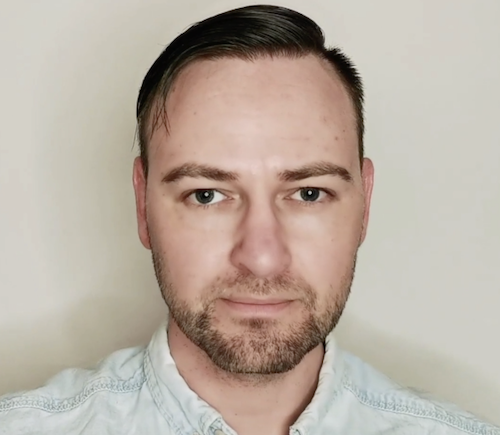
Hair transplantation of the receding hairline: Eliminate and fill in the bald patches
If hair loss remedies and medications cannot do anything about bald patches and corners, but those affected find their situation unattractive and stressful and wish to fill and to permanently eliminate the hairline, then ultimately only a hair transplant can help.
To “fill in” the bald areas, an experienced, renowned doctor will take various criteria into consideration: The appropriate choice of the procedure, a hairline that takes care of both the type and the patient’s taste, and also a hair density that can be expected to give a distinctly aesthetic overall impression as a result. It is advisable to rely on professional competence and in-depth experience when choosing to carry out the operation.
Hair transplantation for receding hairline and two examples of results for men
Example 1 of a receding hairline elimination

Thanks to modern techniques and years of experience in the field of hair transplantation, no one has to put up with their bald corners with a heavy heart nowadays, because help is offered by means of a receding hairline hair transplant!
Example 2 of a hair transplant for hereditary receding hairline
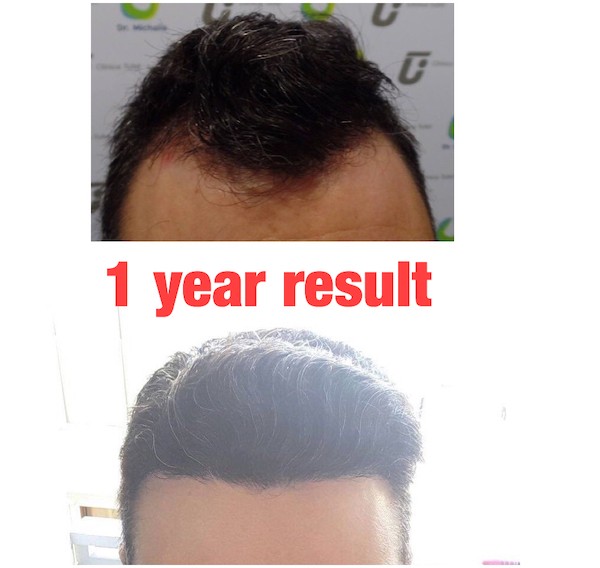
Women’s result example
Example of a women’s corner and hairline fill with 1616 grafts
“For my first hair transplant of the receding hairline, I did not get good advice beforehand. After Hairforlife’s consultation and after the repair hair transplant, I am very satisfied!”
Fitness Couch Alexander

Hair transplantation receding hairline: methods TO Eliminate and Fill the bald corners
To fill in and eliminate the receding hairline (bald corners) through a hair transplant, there are basically two methods that come into question: FUE single removal and the FUT strip technique. The techniques differ mainly in the method of removal, whereby the FUE technique normally (with the exception of Unshaven FUE) requires shaving in the donor area. See the most important information in the following table (depending on your screen resolution, you can scroll the table to the left and right)
| Method comparison | FUT strip technique | FUE single extraction |
|---|---|---|
| Extraction of the grafts/follicular units | In this technique, the hair follicles are removed in a strip of skin from the back of the head and prepared for distribution under a microscope. Depending on the size of the skin strip, 2000 to 4000 grafts (or considerably more, depending on the elasticity of the scalp) can be harvested at once. The resulting wound at the back of the head is then surgically closed | With the FUE technique (single extraction) the hair roots are taken individually from the donor area, isolated into grafts with 1-4/5 hair follicles and transplanted into the thinned out areas. Since hair roots are taken one by one, this method requires more time |
| Duration of the extraction | Depending on the number of grafts, 30 minutes to 1 hour | Depending on the number of grafts and depending on the clinic and whether the harvesting is done manually or with a micromotor, only a few hours. |
| For whom is it suitable? | People with good elasticity of the scalp and people who like to have hair over 1.2 – 1.5 cm long at the level of the scar in the hairline. Also for people with a great need for donor hair and those who do not like to be shaved in the crown of the hair | For lovers of short haircuts who, for example, like to have their hair 1-3 mm short in the crown |
| Anaesthesia | Local anaesthesia always where the work is being done | Local anaesthesia always where the work is being done |
| How many grafts are needed for the receding hairline? | Both techniques! The exact number of grafts needed to remove the receding hairline is very individual. For small receding hairline, only 700-800 grafts may be needed, for medium sized receding hairline 1200-1500 grafts and for very large receding hairline even 2000-2500 grafts may be needed | Both techniques! The exact number of grafts needed to remove a receding hairline is very individual. Small receding hairline may only require 700-800 grafts, medium receding hairline 1200-1500 grafts and very large receding hairline may even require 2000-2500 grafts. |
| Scars | After a strip operation, a linear scar is created. The extent of the scar, the width and thickness of the scar depends on the number of grafts taken, the closure technique, the know-how and experience of the doctor and the elasticity of the scalp, as well as the healing behaviour/scar tendency of the patient. If performed professionally by experienced doctors and if the patient is well prepared, scars of only 1-3 mm can remain, which still allows for quite short haircuts. | After an FUE, small, fine, round scars develop which, however, can hardly be seen by the human eye when professionally removed. The size and visibility of the scars is highly dependent on the know-how and experience of the doctor, as well as the type and size of the removal instruments used. Are the grafts removed manually or with a micromotor? If the latter, with a micromotor from which manufacturer and with which punch sizes? |
| Risk/risks | Donor area: Wider scar which makes it necessary to wear the hair in the crown long. Also the risk of prolonged tightness and numbness Reception area: With both methods poor growth rate unnatural hairline, thick grafts, toilet brush effect, cobblestoning and pitting | Donor area: Decimated hair crown and “overharvesting”, moth-eaten and football field appearance. As a result, this not only brings visual and aesthetic damage, but also ruins the graft reserves in the donor area, with no options for the future. Recipient area: Poor growth rate with both methods, unnatural hairline, thick grafts, toilet brush effect, cobblestoning and pitting |
| When is it possible to do sports again after a hair transplant for the receding hairline? | After the operation, no sport should be done for at least 14 days and fitness training should ideally be avoided for 2-3 months. The risk increases so that the scar expands and a wider scar develops | After an FUE, you can start doing some sport, such as light jogging and cycling, after only 10 days |
| Temporary Shockloss | Both techniques! When the density in still hairy areas is to be increased (but can also occur in adjacent areas of 1-3 cm next to it): When the density in the corners of the receding hairline should be increased, the stress of the surgery, the anaesthetic, etc. can cause existing hair follicles to go dormant, which means that for 3-5 months after the hair transplant you may look slightly worse than before the surgery. Temporary shockloss, however, is only “temporary” and after 3-5 months the situation will gradually improve, when the growth of new hair will also slowly start | Both techniques! When the density in still hairy areas is to be increased (but can also occur in adjacent areas from 1-3 cm next to it): When the density in the corners of the receding hairline should be increased, the stress of the surgery, the anaesthetic, etc. can cause existing hair follicles to go dormant, which means that for 3-5 months after the hair transplant you may look slightly worse than before the surgery. Temporary shockloss, however, is only “temporary” and after 3-5 months the situation will gradually improve, when the growth of new hair will also slowly start |
| Permanent Shockloss | Both techniques! When the density in still hairy areas is to be increased (but can also occur in adjacent areas of 1-3 cm): When the density in the corners of the receding hairline should be increased (in still hairy areas), existing hair can fall into the dormant phase due to the stress of the operation, the anaesthetic, etc. This means that 1. for 3-5 months after the operation you look somewhat worse than before the hair transplant (as with temporary shockloss), but 2. in the case of permanent shockloss, however, the hair is so traumatised by the stress of the surgery, the anaesthetic, etc. that it is damaged forever. The risk is all the higher the thinner the existing hair has already become due to hereditary hair loss. Unfortunately, it is not possible to predict how sensitive hair that has already become thinner is and whether it will survive the surgery or not. | Both techniques! When the density in still hairy areas is to be increased (but can also occur in neighbouring areas of 1-3 cm): When the density in the corners of the receding hairline should be increased (in still hairy areas), existing hair can fall into the resting phase due to the stress of the operation, the anaesthetic, etc., which has the consequence that 1. for 3-5 months after the operation, one looks somewhat worse than before the hair transplant (as in the case of temporary shockloss), but 2. in the case of permanent shockloss, however, the hair is so traumatised by the stress of the surgery, the anaesthetic, etc. that it is damaged forever. The risk is all the higher the thinner the existing hair has already become due to hereditary hair loss. Unfortunately, it is not possible to predict how sensitive hair that has already become thinner is and whether it will survive the surgery or not. |
| Is a shave necessary for the hair transplant of the receding hairline? | No at the back of the head and no in the area to be transplanted. However, depending on the hair situation, a hair surgeon may recommend shaving in the reception area | The back of the head is usually yes and the area to be transplanted is usually yes. However, there are now some hair surgeons who at least do without a shave in the recipient area and only shave in the donor area. In the donor area, either a strip shave or a GJ cut can be performed (depending on the number of grafts). In the meantime, there is also an FUE without any shaving, the Unshaven FUE variant without shaving in the receiving area plus no shaving in the harvesting area. However, this method is expensive and is only performed by very few hair surgeons |
| Hair transplant of receding hairline and social skills | Depending on the shave, a 14-day leave of absence is generally recommended. If there is still enough remaining hair and if this is not shortened in the recipient area and thus the cover for the resulting traces in the corners after the operation (redness/crusting) is possible (e.g. by wearing a pony), then it may be possible to go to work again one day after the receding hairline transplantation without anyone being able to recognise a surgical intervention (often possible when transplanting a smaller number of grafts) | Depending on the shave, 14 days off is generally recommended. If there is still enough hair left and if it is not shortened and if it is possible to cover the traces in the corners after the operation (redness/crusting) (e.g. by wearing a pony), then it may be possible to go to work for less than a week or it is even possible to go back to work one day after the receding hairline transplantation without anyone being able to recognise a surgical intervention (often possible when transplanting a smaller number of grafts) |
| Does the health insurance cover the costs of a receding hairline hair transplant? | Both techniques! No. Since it is not a medically necessary surgery, you have to bear the costs of the receding hairline transplantation yourself. | Both techniques! No. As it is not a medically necessary surgery, you have to pay for the hair transplant of the receding hairline yourself. |
How much does a hair transplant cost?
How much does it cost to have the bald spots in the receding hairline removed with a hair transplant?
In the end, the prices depend not only on the respective technique and the respective clinic, but also on the necessary number of grafts, and the number of grafts depends on the following points, among others:
- What goals have I set for myself?
- How high/deep should my new hairline be and where exactly do I want to have the hair transplanted?
- How large is the area that is to receive new hair?
- What density should be achieved?
The exact number of grafts to be “transplanted” also depends:
- On the characteristics of the donor hair (crown of hair). This means the density of the “ring of hair”, the diameter of the hair shaft, the colour of the hair (the contrast between the scalp and the hair) and whether the hair is curly, wavy or straight.
Rough estimate of the number of grafts needed TO eliminate and fill receding hair line with hair transplant
Please bear in mind, however, that this scheme only serves as a first rough guide to a preliminary number of grafts for the hair transplant of the receding hairline. For a more detailed assessment and advice from Hairforlife, contact Hairforlife via the contact form and also read the notes here regarding an online hair transplant consultation.
The possible costs for transplanting a Norwood scale II and IIa situation:

Possible graft number for the receding hairline hair transplantation in this hair situation: 1500
FUE (FUE & FUI) 3750 Euro – 7500 Euro depending on country and doctor
FUT (strip & FUI) 2250 Euro – 5250 Euro depending on country and doctor
The possible costs for transplanting a Norwood scale III , IIIa and III vertex situation:

Possible graft number for hair transplant of the receding hairline in this hair situation: 2250 – 3000
FUE (FUE & FUI) 5625 Euro – 15000 Euro depending on country and doctor
FUT (strip & FUI) 4050 Euro – 10.500 Euro depending on country and doctor
Read also here about the prices
Hair restoration surgery for receding hairline and the risks: Example of a failed surgery with repair
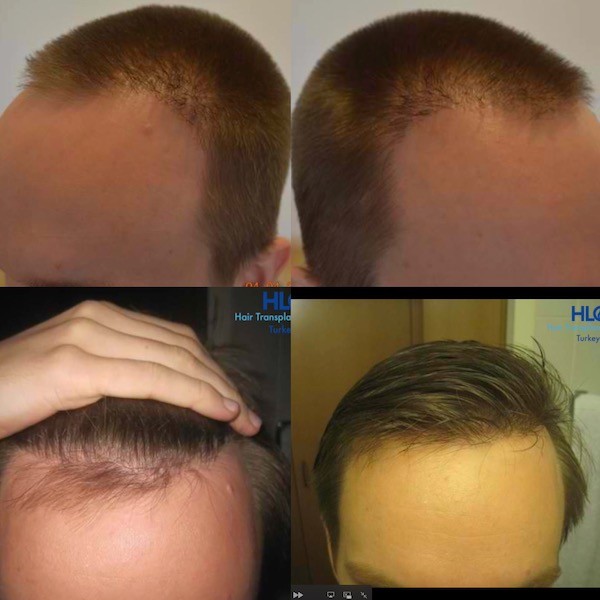
The picture above shows a failed result of a receding hairline hair transplantation with poor growth rate, wrong growth direction and thicker grafts and below the result of the repair surgery, achieved by Hairlineclinic
The risks of a hair transplant of the receding hairline are that when the grafts/hairs are transplanted by a doctor who does not specialise in hair transplantation and is inexperienced with hair restoration surgeries, the new hairs are transplanted in the wrong direction of growth, or that thicker grafts, so-called follicular units with 3 and 4 hairs, are transplanted in the front line, which leads to massive unnatural results, or simply only a poor growth rate is achieved.
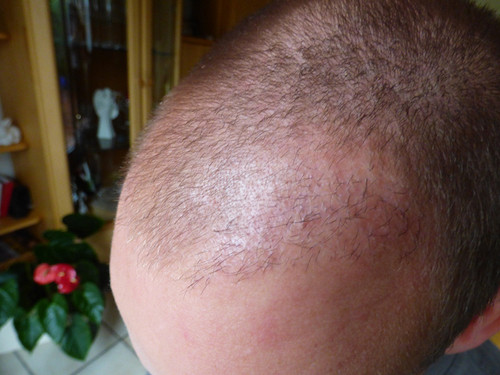
“Many of the illegal clinics have fancy websites with references and testimonials that look very professional. However, the reality is that the hair transplant may be carried out by someone who has no medical training.”
Read more about the ISHRS.org “Fight The Fight” campaign

Campaign against illegal “black market clinics” World Association for Hair Surgery ISHRS.org
Hair transplantation receding hairline and general questions and answers
Hair transplantation of the receding hairline is possible for both men and women. Provided there is hereditary hair loss (androgenetic hair loss/AGA) and there is still enough hair available in the harvesting area (hairline/donor area) that can be harvested and transplanted as donor hair. Consequently, patients with other diagnoses of hair loss and patients with too few donor hairs (insufficient hair crown) cannot be treated with hair restoration. These include, for example, those affected by alopecia areata and also those affected by diffuse hair loss.u003cbru003eu003cbru003eHowever, it is important for young men that the transplant is well planned and that the donor reserves are well u0022managedu0022. This is because an operation on the patient’s own hair is not a hair transplant and the donor hair can only be removed to a limited extent. In young men, future hair loss is often very difficult to assess and if, for example, baldness is imminent and donor reserves for a deep hairline have already been u0022wastedu0022 at a young age, then these are no longer available for other areas that are still balding and there is a risk of large bald areas.
The transplanted hairs will most likely grow u0022stablyu0022 in the receding hairline for life! The hair follicles taken from the donor area are considered to be insensitive to the hair loss-causing dihydrotestosterone (subhormone of DHT) and after the transplantation, the transplanted hairs retain their genetic specifications (the insensitivity) also at their new location. They will therefore continue to grow there and not fall victim to hereditary hair loss.u003cbru003eu003cbru003eHowever, it is important to know that the scientific basis of hair transplantationu003csupu003e5u003c/supu003e is that the new hairs from the donor area will only grow in the new area as long as they would have in their original location.u003cbru003eTherefore, it must always be mentioned that the results can become thinner with age, namely when the hair crown thins out somewhat with age, especially with high NW degrees such as NW 6.u003cbru003eu003cbru003eIt is also very important to know that if the hereditary hair loss continues, the transplanted hair follicles will continue to grow, but without further intervention, ugly gaps can develop, so-called devil horns, with the consequence that one is forced to have another transplant due to the unsightly and unnatural appearance. In very young people with aggressive hair loss, it can lead to an almost never-ending story, so to speak, and surgery follows surgery and at some point the donor hair reserves are also used up and, for example, in the NW 6 case (full baldness), even larger bald areas remain.u003cbru003eu003cbru003eFor information: The majority of hair surgeons assume that the active ingredient finasteride can stop or at least weaken the above-mentioned process (that hair crowns thin out with age). Finasteride is also recommended for young people who have undergone hair transplantation in order to slow down further hair loss or, in the best case, even stop it. Please also read u003ca href=u0022https://hairforlife-international.com/en/stop-hair-loss/u0022 data-type=u0022pageu0022 data-id=u00226611u0022u003eu0022Stopping and remedying hair loss with medicationu0022u003c/au003e.
No! As already noted above, a hair transplant is not a hair multiplication, but only a hair redistribution! The amount of hair follicles to be harvested in the hair ring is limited. Therefore, every serious hair surgeon will handle the available donor grafts as carefully and economically as possible, especially in young people!u003cbru003eu003cbru003ePlaces that are important for the visual appearance, such as the front areas with the hairline, are planted more densely and other areas are given less density. In the end, a hair transplant is always just an illusion of significantly more hair than is actually present on the head!u003cbru003eu003cbru003eTheoretically and technically, modern hair surgeons achieve hair densities by means of u003ca href=u0022https://hairforlife-international.com/en/hair-transplantation-dense-packing/u0022 data-type=u0022pageu0022 data-id=u00228460u0022u003edense packingu003c/au003e that are almost as high as those grown naturally even at a young age (especially if the hair is transplanted again), but this is often not a good idea for young people. As mentioned above, hair loss can progress quickly and later, in the case of full baldness, there is a serious distribution problem, large areas have to remain bald and, in retrospect, those affected wish they had used their donor reserves more sparingly at a young age.
How many grafts you need to eliminate and fill receding hairline through a transplantation depends on several individual factors: What are the goals? How high/low should the hairline be set? How large is the area to be planted? What density should be transplanted?u003cbru003eu003cbru003eIn addition, the number of grafts required always depends on the characteristics of the donor hair (hair colour, hair thickness, hair structure (wavy, curly or straight hair), as can also be read in the article u0022Hair Restoration Surgery: The State of the Artu0022u003csupu003e6u003c/supu003e.u003cbru003eu003cbru003eRoughly speaking, only 700-800 grafts may be needed for small receding hairline, 1200-1500 grafts for medium receding hairline and even 2000-2500 grafts for very large receding hairline.
Patients who have already had a hair transplant describe it as a similar experience to going to the dentist. Before the surgery, you always receive a local anaesthetic in the treated areas. The incisions are made carefully and are easily tolerated. After the hair transplant, however, there may be soreness and feelings of tension and numbness. The pain can be managed well with light painkillers and the feelings of tension and numbness gradually improve until they have completely disappeared.
– 4-5 days before the treatment you should abstain from all alcohol consumption as well as coffee on the day of the hair restoration surgery.u003cbru003eu003cbru003e- Go to bed early the day before the surgery so that you can start the operation well rested.u003cbru003e7 days before the treatment you should refrain from taking food supplements and/or drinking vitamins that contain vitamin B and/or Eu003cbru003eu003cbru003e- On the day of the treatment, wear comfortable clothing such as a shirt that does not have to be pulled over your head to be put on or taken off.u003cbru003eu003cbru003e- 10 days before the hair transplant of the receding hairline, do not take any medication containing aspirin/acetylsalicylic acid or any medication similar to aspirin (ibuprofen, diclofenac, etc. …). The same applies to any kind of stimulants and/or anesthetics. However, if you are in pain before the treatment, the painkiller paracetamol is allowed.u003cbru003eu003cbru003e- Do you have to take medication prescribed by a doctor on a regular basis? Please inform your hair surgeon in advance.u003cbru003eu003cbru003e- If you have been prescribed medication against blood coagulation disorders (coumarin-containing, e.g. Marcumar), this must also be made known before the treatment and your treating family doctor must be consulted.u003cbru003eu003cbru003e- Do you use hair loss remedies containing minoxidil such as Regaine, Regain, Rogaine, Lipoxidil? Please discontinue these 7 days before the hair transplantation.u003cbru003eu003cbru003e- The active ingredient finasteride (Propecia/Proscar) may continue to be taken.
After the receding hairline hair transplant, there may be slight, sometimes considerable swelling in the area of the corners/recipient area. After about 2-3 days, these may also appear on the face. All in all, perhaps similar to a boxer after a fight. There is usually no pain, but many patients feel disfigured and therefore avoid the company of others until the swellings have subsided (after about 5-7 days). In order to support a complication-free, optimal healing after the operation, heavy work, sweating, dust and moisture as well as sports should be avoided for 2-3 weeks. You should wait about 4 weeks before resuming the wearing of a toupee, going to the sauna, swimming (with regard to chlorine) and strong sun exposure (also use of a solarium).
Yes, after the treatment, the transplanted hairs first fall into a resting phase until they start to grow after 3-5 months. The actually filled-in receding hairline is then empty again for a few weeks/months until it gradually becomes hairy again.
Approximately 1-2 days after the receding hairline hair transplant, painless but unattractive swellings develop, which are also visible in the face under the receding hairline in the form of a puffy appearance and cause an overall feeling of discomfort. About 5 days after the procedure, the swellings have subsided to the extent that nothing unusual is noticed by third parties (in some cases this can take up to 3 weeks).u003cbru003eu003cbru003eAfter the treatment, crusts appear on the treated areas in the corners/receding hairline, but they disappear after about 10 days. Many patients therefore plan a holiday for this period and usually manage with 2 weeks. After the crusts fall off, the scalp in the receding hairline appears pink to red, which is familiar from other healed wounds.u003cbru003eu003cbru003eIt can take up to 2-3 months for the skin to adapt to the colour of the rest of the scalp. A cosmetic concealer, which is available in many skin colours in pharmacies and drugstores, can help. If new hair (grafts) has been transplanted in the midst of existing residual hair (or in marginal areas such as 1- 3 cm next to the transplanted receding hairline), the overall appearance of the hairstyle can still give an unattractive impression for about 3-5 months.u003cbru003eu003cbru003eOn the one hand, this is due to the slight colour deviations of the skin and on the other hand, because the remaining hair goes into a resting phase due to the so-called u0022shock fall-outu0022. It can take up to 3-5 months until the remaining hair starts to grow after this resting phase and also the new, transplanted hair. Therefore, a rather worse hair situation is to be expected for this period of time.
No, not necessarily. With the u003ca href=u0022https://hairforlife-international.com/en/hair-transplant/fue-hair-transplant/u0022 data-type=u0022pageu0022 data-id=u00222336u0022u003eFUE methodu003c/au003e, usually at least the hair in the donor area must be shaved so that the fine hollow needle (the punch) of 0.8 – 1 mm in diameter can be inserted into the skin around the follicular unit and the graft removed. In the recipient area, hair can often be left long after consultation with the hair surgeon.u003cbru003eu003cbru003eHowever, there are hair surgeons who prefer a full shave, especially if some preventive thickening is to be done in the peripheral areas next to the corners, and this issue should always be clarified before the surgery.u003cbru003eu003cbru003eIn the meantime, however, FUE hair transplantation offers the possibility of u003ca href=u0022https://hairforlife-international.com/en/fue-hair-transplant-without-shaving/u0022 data-type=u0022postu0022 data-id=u00225240u0022u003ehair surgery without any shaving, neither in the hairline nor in the recipient areau003c/au003e, i.e. also not around the corners.u003cbru003eu003cbru003eDue to the higher time expenditure and the fact that a lot of experience and know-how is required, this type of hair transplantation is only offered by very few hair surgeons.u003cbru003eu003cbru003eAlternatively, there is also the possibility of leaving the hair in the reception area long and either shaving the hair in the hairline completely, see also a u003ca href=u0022https://hairforlife-international.com/en/hair-transplant/fue-gj-cut-part-shaves-shaving-of-stripes/u0022 data-type=u0022pageu0022 data-id=u00223020u0022u003eGJ cutu003c/au003e, or a u003ca href=u0022https://hairforlife-international.com/en/hair-transplant/fue-gj-cut-part-shaves-shaving-of-stripes/u0022 data-type=u0022pageu0022 data-id=u00223020u0022u003epartial shave/stripe shave u003c/au003e(however, only smaller numbers of grafts can be transplanted with this).
Many patients wish to be socially acceptable again quickly after the transplant (especially for women, shaving a large area is often unthinkable).u003cbru003eu003cbru003eHowever, after consultation with the hair surgeon, the hair in the recipient area can remain long.u003cbru003eThis has the advantage that if the remaining hair in the middle and around the corners is still in good condition, the traces of the surgery (crusts/redness) can be well covered by the longer hair.u003cbru003eu003cbru003eNormally, the recommended holiday period is about 14 days. But, for example, there is a chance that no holiday is needed at all if the traces of the operation can be well covered by wearing fringes and if there is also little shaving in the donor area. Then you may even be able to go back to work the day after the operation, especially after an u003ca href=u0022https://hairforlife-international.com/en/fue-hair-transplant-without-shaving/u0022 data-type=u0022postu0022 data-id=u00225240u0022u003eUnshaven treatment without any shaving (not in the recipient area and also not in the donor area)u003c/au003e.

In the period of 2-6 weeks after transplanting the hair, the hair follicles first fall out again. However, this is no cause for concern: the transplanted hair suffer a lack of oxygen in the course of the treatment, fall into a resting phase and reject the hair.u003cbru003eu003cbru003e3 to 5 months after the receding hairline transplantation, the first hair roots begin to develop new hair again – gradually and also at different rates, depending on the patient. Small pimples may also appear, which are caused by a new hair shaft making its way out.u003cbru003eu003cbru003e6-10 months after the grafts have been transplanted, the planted areas become increasingly dense. Even in month 11, serious positive changes can often still be seen until the final result is expected in month 12 and the receding hairline should be fully overgrown again.u003cbru003eu003cbru003eInfo:u003cbru003eu003cbru003eThere are also cases in which significant new growth only became apparent after 6-8 months, but also patients who could already make out a remarkable increase in hair and thus an astonishing optical enhancement after 3-5 months. Although these cases are the absolute exceptions, they should not go unmentioned.u003cbru003eu003cbru003e12 months after the hair transplant, full growth is usually achieved, so that one can speak of the final result after 12 months. However, positive changes in the appearance can often still occur after 12 months up to 18 months after the procedure. Since here and there a few hairs still gain thickness!
No, but this would be advisable – especially for young people. If the hair loss behind the receding hairline progresses, a new transplant will be necessary because unsightly and unnatural gaps will appear. Medications such as finasteride and/or minoxidil can help to slow down further hair loss as much as possible, or in the best case even stop it.
Yes, there are scars with every surgery. With the FUT technique there is a linear scar, which can usually be sufficiently concealed by longer hair in the donor area, and with the FUE technique there are small, fine, round scars, which are usually hardly noticed as scars by outsiders, even with short hair.
No. Unfortunately, the costs of hair transplantation are generally not covered by health insurance.
More examples of successful hair transplantations of the corners
Before and after pictures
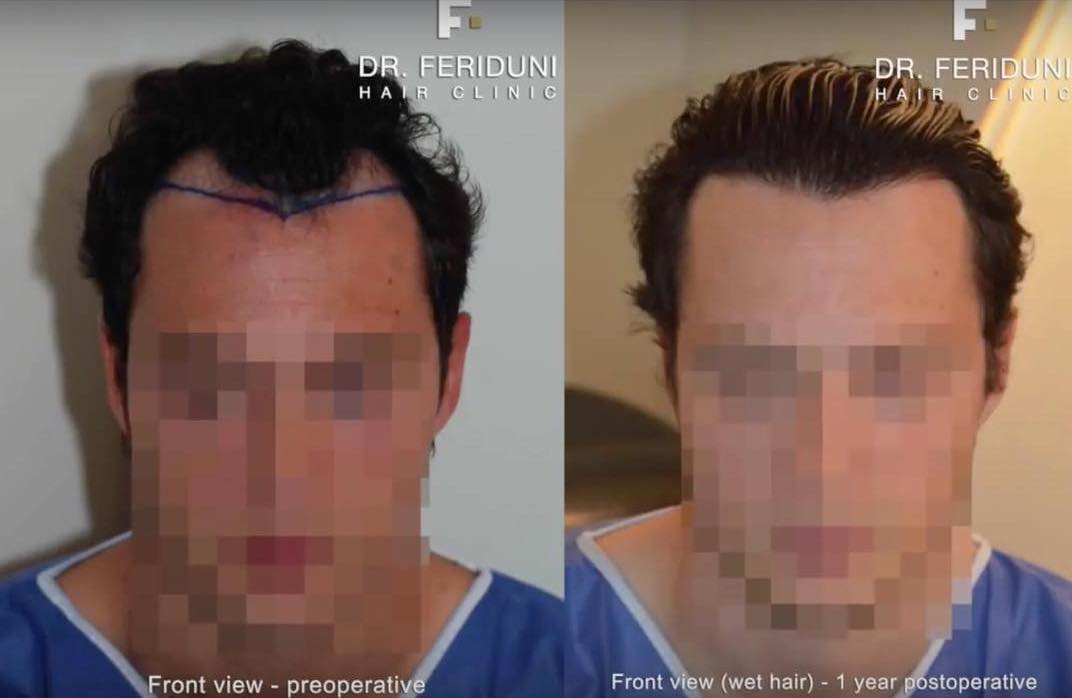


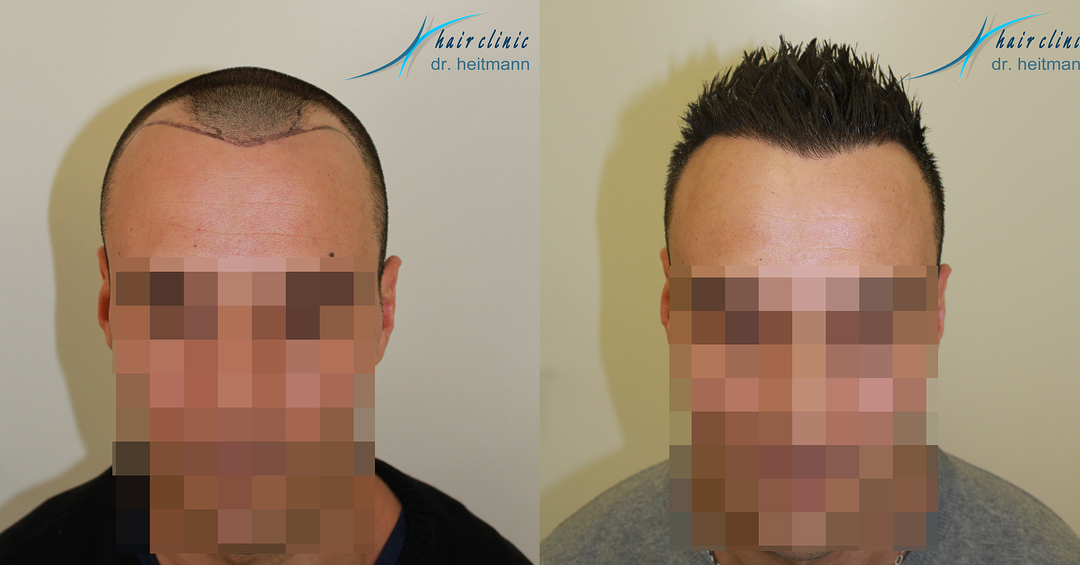
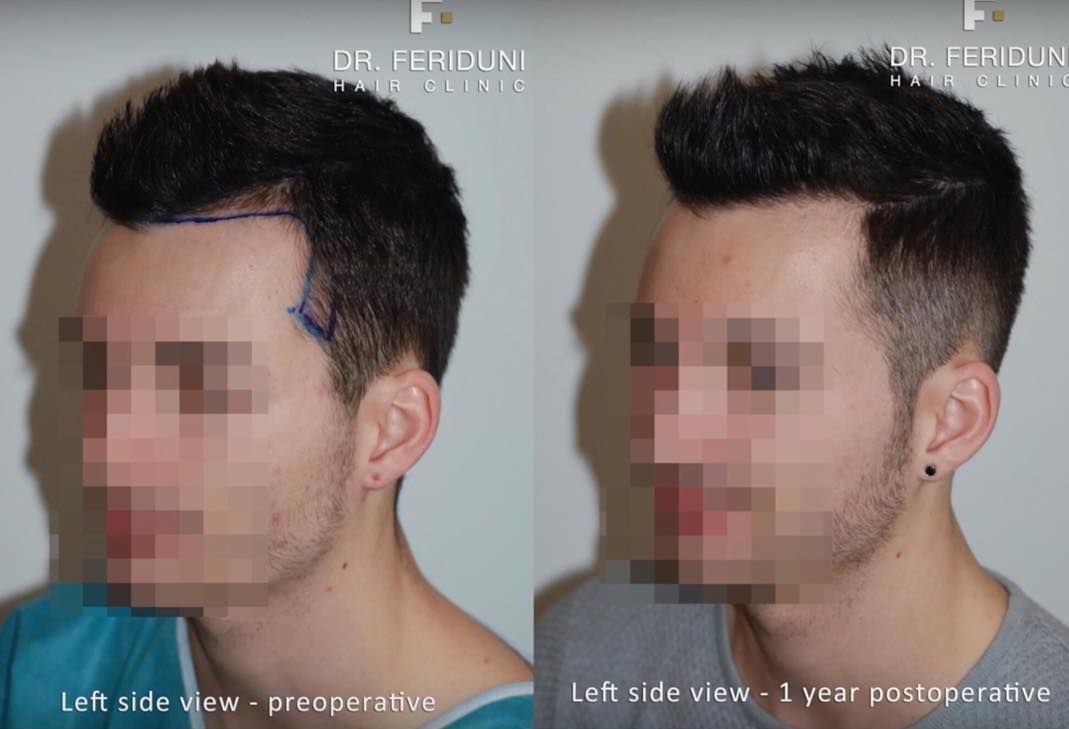

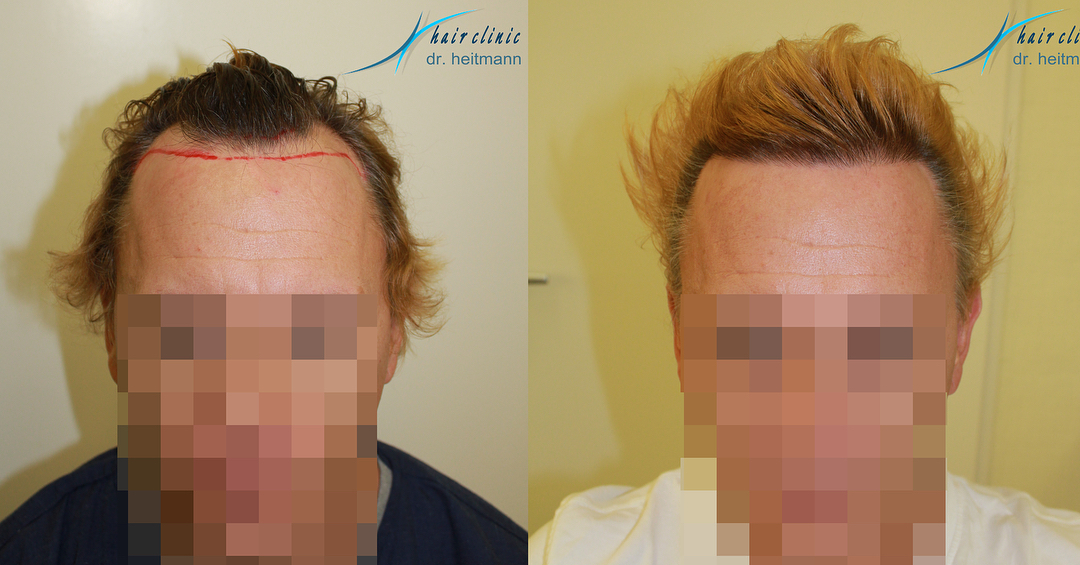

Result videos
An FUE with 1906 grafts by Dr. Bijan Feriduni:
FUE hair transplantation of the receding hairline with 1200 grafts by Dr. Lars Heitmann:
1800 grafts from the Hairlineclinic in Ankara/Turkey:
Sources/References/Author
1 https://de.wikipedia.org/wiki/Geheimratsecken
2 https://www.pharmazeutische-zeitung.de/ausgabe-452015/von-geheimratsecken-bis-zur-glatze/
3 https://www.pharmawiki.ch/wiki/index.php?wiki=Alfatradiol#:~:text=Alfatradiol%20inhibits%20the%20enzyme%205%CE%B1,Alfatradiol%20practically%20has%20no%20%C3%B6strogenic%20effects.
4 https://www.oekotest.de/gesundheit-medikamente/Mittel-gegen-Haarausfall-im-Test-Mehr-als-die-Haelfte-faellt-durch-_96471_1.html
5 https://www.ncbi.nlm.nih.gov/pmc/articles/PMC2825128/
6 https://www.researchgate.net/publication/233738772_Hair_Restoration_Surgery_The_State_of_the_Art
Author


